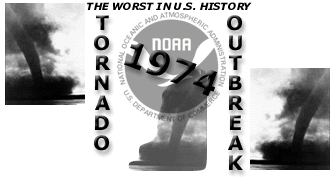 This week marks the 25th anniversary of the April 3-4, 1974, super tornado outbreak. It was the worst tornado outbreak in U.S. history with 148 twisters touching down in 13 states. Before it was over 16 hours later, 330 people were dead and 5,484 were injured in a damage path covering more than 2,500 miles. Twenty-five years ago, National Weather Service forecasters could see only green blobs on their radar scopes and had to wait for visual confirmation of the tornado before issuing a tornado warning. Today's forecasters, thanks to a $4.5 billion weather service modernization effort, view evolving storms in graphic detail and can now issue warnings before tornadoes even form, with an average lead time of 11 minutes. "Deadly storms such as the 1974 super outbreak can and will happen again," said Ken Haydu, meteorologist in charge of the National Weather Service's forecast office in Wilmington, Ohio. "The people who experienced the super outbreak have an important story about tornado awareness and preparedness to pass on to later generations." In all, 13 states were struck by twisters: Alabama, Georgia, Illinois, Indiana, Kentucky, Michigan, Mississippi, North Carolina, Ohio, South Carolina, Tennessee, Virginia, and West Virginia. Here you'll find information on the 1974 super outbreak including an audio description of the Louisville tornado by John Forsing, a report on how the tornado outbreak opened eyes about tornado myths and school safety, National Weather Service eyewitness accounts, and sidebar stories.
|